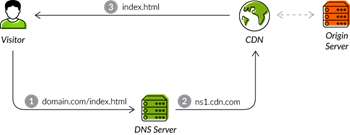The Future Of The Internet — CDN And The Investments Your Site Requires
By Jessica Foreman, contributing writer
When you think of the future of the internet, you probably think one thing: life will be spectacular. A social media platform that identifies when people are lying about how awesome their lives are and iPads that double as hover boards would be spectacular, indeed.
However, for website owners, there’s another type of spectacular when it comes to the internet: the type that helps improve website performance, user experience, and ultimately the bottom line. Infrastructure as a Service (IaaS) in general and Content Delivery Networks (CDNs) specifically are set to explode over the next four to five years for those exact reasons.
Infrastructure as a (Booming) Service
IaaS is a form of cloud computing that makes virtualized computing resources available over the internet. It fits in with Software as a Service and Platform as a Service as one of the three main cloud computing services.
With IaaS, a provider hosts software, hardware, storage, servers, and other infrastructure components for its clients. IaaS providers also host clients’ applications and provide services like system maintenance, system backups and resiliency planning.
The major benefits of IaaS are that it’s majorly scalable and adjustable on-demand. It also allows organizations to massively reduce IT costs and burdens, allowing them to focus instead on their core operations. Thanks to these advantages, IaaS is already a massive industry, weighing in worth a whopping $15.79 billion USD. By 2020 that figure is expected to more than triple to $56.05 billion.
The IaaS You Want For Your Website — The Latency-Reducing CDN
In fairness, there may be a large handful of IaaS components you want for your website. But if you absolutely had to pick just one, it would probably be the previously mentioned content delivery network.

How a CDN functions. Full resolution photo can be found here
A CDN is so named because it uses a global network of servers to deliver your website’s content to your website visitors as efficiently as possible. According to CDN provider Incapsula, the biggest thing a CDN does is reduce latency — the delay between a request and the actual delivery of content on a website. This is a pretty big deal because, as outlined in the link above, a mere one second delay in a page’s load time results in 7 percent fewer conversions, an 11 percent drop in page views, and a 16 percent reduction in customer satisfaction.
See You Later, Latency
A CDN reduces latency by providing a global network of servers, which means no matter where in the world your website visitors are, they will be redirected to a server located near them. Since visitors being geographically close to a server is one of the most important factors in a website’s performance, this global network offers a major advantage for websites receiving international traffic.
CDNs also provide load-balancing. As a multiple server environment it eliminates the possibility of a single server being overwhelmed by traffic. This helps guard against major influxes of legitimate traffic as well as malicious traffic, meaning CDNs also offer protection against DDoS attacks. Not only does DDoS protection prevent website latency, it also prevents website downtime, which can be devastating in many online industries.
CDNs are designed to, of course, deliver content more quickly. This often means compressing files and stripping unnecessary characters in your source code. A CDN also determines how best to use your website’s resources when it comes to bandwidth-heavy content like video files or live broadcasts. In addition, an advanced CDN will also be excellent for caching both static and dynamic content.
Lastly, a CDN boosts a website’s efficiency managing user connections, reusing open connections wherever possible.
Trust The Numbers
You’ve already seen that IaaS is set to explode, and so too are CDNs - specifically mobile CDNs that work to optimize a mobile device’s performance by delivering content more efficiently while also reducing how much data is used.
Mobile CDNs are focused on better delivering both video and non-video content. Regardless of content type, the ability of a mobile CDN to redirect a mobile user to a nearby server will make the biggest difference in website or app performance. For non-video content specifically, one of other the biggest advantages a mobile CDN offers is content caching. For video content, a mobile CDN provides device detection, video transcoding, image rendering and bit-rate adaptation.
Until 2019 the CDN market is expected to grow at a compound annual growth rate of 24.45 percent. The mobile CDN network market alone is expected to be worth $13.4 billion USD by 2020. This actually makes perfect sense as the number of people accessing the internet using a mobile device has skyrocketed over recent years, actually bypassing the number of people accessing the internet using a desktop computer.
Keeping Up With Or Bypassing The Joneses
In today’s online environment, you need to either keep up with your competition, or get out in front of them. That means giving your website visitors the best possible website performance; this means investing in a CDN before you’ve already been written off by visitors for your latency issues.
Jessica Foreman is a Durham University graduate specializing in business, security and lifestyle based writing. She has developed her skills on projects surrounding The British Broadcasting Company, and running a print and online based magazine whilst at university. She is currently looking towards starting her Masters in Mobile and Personal Communications as well as broadening her horizons through travelling.
